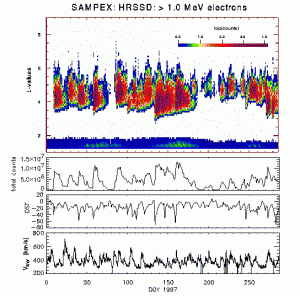SAMPEX observes correlation between precipitating electrons and geomagnetic indices
The observations of time scales for high energetic electrons throughout the terrestrial radiation belts are of great interest in magnetospheric physics. These electrons also have a large practical importance because of their potential hazard on spacecraft subsystems. SAMPEX data show an abrupt electron enhancement throughout the=20 magnetosphere on a time scale of one and two days. They have a lifetime of about 10 days and they are correlated with arriving co-rotating interaction regions. Therefore, of particular interest is the effect of the occurrence of precipitating electrons and the correlation with solar activity and solar wind conditions on the one hand, and on the other hand the correlation with geomagnetic indices obtained from ground based measurements.
A comprehensive view is provided in Figure 1. From top to bottom these panels show the daily electron intensity measured with the HILT instrument onboard SAMPEX during 1997, sorted at different L-values. The next panel shows the L-integrated intensity for an easier comparison with the Dst index (next panel), and the solar wind speed measured with the proton monitor of the CELIAS experiment onboard SOHO spacecraft (bottom panel).
This investigation has shown that the highest correlation is between the onset of the precipitating electrons and large values of negative Dst indices, i. e. large magnetic storms. The data also show a good correlation between the sudden increase of the electron intensity with high-speed solar wind streams. A long term statistical analysis over several years at low as well as high solar activity may provide a more consistent picture of the physical processes in the magnetosphere, their dependence on the solar wind conditions and their relation to data obtained from ground based measurements.
Contributed by Harold Kucharek and Berndt Klecker, Max-Planck-Institute
«Return to the Results page
